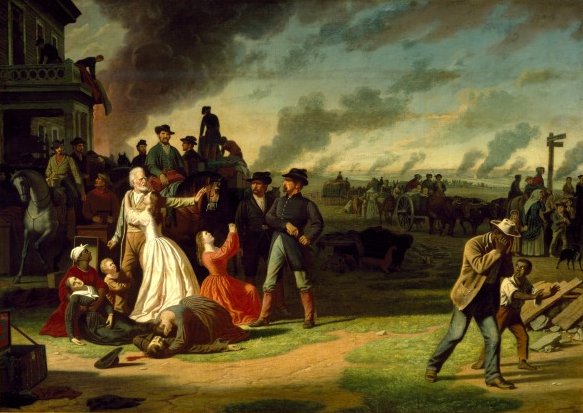By Jeremy Neely, Missouri State University
Event Summary:
- Date Issued: August 25, 1863
- Locations Affected: Jackson, Cass, Bates, and northern Vernon counties, excluding non-rural areas
- Persons Affected: All citizens who could not prove their loyalty to the Union
- Issued by: Brig. Gen. Thomas Ewing Jr., commander of the District of the Border
- Result: Much of northwestern Missouri emptied of its population; property confiscated; becomes known as the "Burnt District"
In a controversial attempt to quell guerrilla warfare along the Missouri-Kansas border, Union General Thomas Ewing issued General Order No. 11, exiling several thousand people from their homes in western Missouri. The August 25, 1863, orders required that “all persons” living in Jackson, Cass, Bates, and northern Vernon counties “remove from their present places of residence.”
From Order No. 11:
"All persons living in Jackson, Cass, and Bates counties, Missouri, and in that part of Vernon included in this district, except those living within one mile of the limits of Independence, Hickman's Mills, Pleasant Hill, and Harrisonville, and except those in that part of Kaw Township, Jackson County, north of Brush Creek and west of Big Blue, are hereby ordered to remove from their present places of residence within fifteen days . . ." (read the rest)
This policy marked the culmination of the army’s long struggle against guerrilla violence along the Missouri-Kansas border. Federal troops struggled to engage and defeat pro-Confederate guerrillas. These so-called “bushwhackers” enjoyed considerable support from Southern sympathizers, who provided them with food, clothing, horses, and shelter. Some Missouri women also assisted them as spies. By late summer, frustrated Union officers concluded that order could not be restored without removing the families who sustained the guerrilla resistance.
Exemptions to the policy were limited. Among those excepted were inhabitants of Kansas City, Westport, and Independence, where Union forces maintained greater control. The measure likewise spared those who could prove their Unionist loyalties to the satisfaction of local military commanders. The army required that such persons relocate to Kansas or within one mile of its posts at Independence, Hickman Mills, Harrisonville, and Pleasant Hill.
Order No. 11 was General Ewing’s response to a recent escalation of tensions and violence in the area, for which he himself was not blameless. In early August, Ewing ordered the arrest, detention, and removal of female kinfolk of known guerrillas. A makeshift jail in Kansas City that held several of these women collapsed. Among the five women who died were sisters of the infamous guerrilla William “Bloody Bill” Anderson. Six days later, Anderson’s fellow bushwhacker, William Clarke Quantrill, led a band of more than 400 guerrillas in a surprise attack on Lawrence, Kansas, which resulted in the murder of between 160 and 190 men and boys. Northern critics assailed Ewing for failing to stop Quantrill’s raid. The general, fearing a reprisal attack against civilians in Missouri, then issued his depopulation order.
To prevent roaming guerrillas from foraging upon the countryside, the order empowered federal troops to seize displaced families’ grain and hay crops. Soldiers and bandits plundered abandoned properties and set many farmsteads ablaze. The flames spread to the adjoining tallgrass prairies and quickly consumed much of the landscape. The resulting desolation moved observers to describe Cass and Bates County as the “Burnt District.”
A reproduction of the painting Martial Law (or Order No. 11), by George Caleb Bingham, is displayed in Kirk Hall at the Central Branch of the Kansas City Public Library.
Contemporaries debated the effectiveness of Ewing’s order well into the late 19th century. Many defenders noted that guerrilla violence did indeed drop sharply in the affected counties. Others claimed erroneously that the measure displaced few people. Critics charged that the policy brought undue hardships upon innocent women, children, and several Unionist households. One such critic, Missouri artist and Union officer George Caleb Bingham, immortalized the policy in his painting, Martial Law (or Order No. 11). Bingham’s artwork, which underscored the order’s brutal execution, helped fuel the notoriety that followed Ewing throughout his postwar political career.
Most of the families exiled by the order relocated temporarily to other points in Missouri. A large number of the dispossessed came back to the area after 1865. Many others never returned.
Suggested Reading:
Goodrich, Thomas. Black Flag: Guerrilla Warfare on the Western Border, 1861-1865. Bloomington: Indiana University Press, 1995.
Neely, Jeremy. The Border Between Them: Violence and Reconciliation on the Kansas-Missouri Line. Columbia London: University of Missouri Press, 2007.
Whites, LeeAnn. "Forty Shirts and a Wagonload of Wheat: Women, the Domestic Supply Line, and the Civil War on the Western Border," Journal of the Civil War Era 1, no. 1 (March 2011): 56-78.
Cite This Page:
Neely, Jeremy. "General Order No. 11" Civil War on the Western Border: The Missouri-Kansas Conflict, 1854-1865. The Kansas City Public Library. Accessed Friday, April 19, 2024 - 15:21 at https://civilwaronthewesternborder.org/encyclopedia/general-order-no-11


